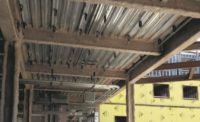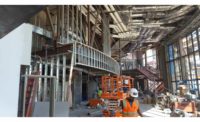When evaluating the prospective location for a multi-family residential project, there are many factors that should be considered. Chief among them is a factor that is often overlooked: potentially intrusive existing noise sources around the building site. Here in the greater Boston area, Acentech has consulted on several residential projects along major transit lines. Noise from the Mass Pike and other highways, the commuter and light rail system, and Boston’s Logan Airport bombard building façades with high levels of noise. Special consideration is needed to ensure that noise from these modes of transit is addressed appropriately. And while it’s true that robust façade constructions on residential buildings near high-traffic areas are often imperative for the comfort of residents, they can also result in significant additional costs to the project if overdesigned.
With any residential project site near road, rail, or airport noise sources, the construction of the building envelope is especially crucial to the design process. From an acoustic standpoint, the window construction is most critical in achieving the desired overall sound isolation performance of the envelope, since windows typically have lower sound isolation ratings than standard exterior walls. In many cases, a typical 1-inch insulated glazing unit is not sufficient to attenuate exterior transit noise to an acceptable level. Varying the thickness or number of the lites, upgrading to laminated glass, or increasing the airspace between lites all impact the overall sound isolation capabilities of the window assembly. Modifications to one or more of these elements of the window are often necessary to attenuate transit noise. On one hand, specifying windows that do not provide the necessary level of sound isolation may result in disturbed and angry residents; on the other hand, installing a window with an excessively high sound isolation rating has diminishing returns, and can add unnecessary expense to the project.
Evaluation Process and Establishing Noise Goals
Before any decisions can be made regarding the building envelope, an evaluation of the project site should occur. Acentech’s process for evaluating environmental noise at a project site typically involves deploying long-term sound level meters at critical locations near the planned future façade. These meters collect noise data over the course of several days and nights, both during the week and weekend. We use this data to quantify the potential impact from steady-state and transient noise sources, each of which needs to be addressed to satisfy different noise goals.
Steady-state noise comprises the consistent noise levels that occur for extended periods of time during a certain time window, such as HVAC noise or consistent vehicle traffic along a highway. By performing a weighted average of noise data collected over the course of a 24-hour period, a Day-Night sound level, or DNL, can be calculated to describe the consistent noise level of a site in a single number. In our experience, we have encountered calculated DNL as high as 81 dBA for residential projects, which translates to about the noise level of a blender or garbage disposal.
Table 1 in Chapter 48 of the American Society of Heating, Refrigerating, and Air-Conditioning Engineers (ASHRAE) handbook establishes recommended interior noise levels for HVAC related background sound for several project types. As outlined in this table (shown below), a typical background noise goal for residential living spaces is 35 dBA, and 40 dBA for bathrooms, kitchens, and other supplementary spaces.1 Designing a building façade such that intrusive noise from traffic is at or below these levels results in steady-state traffic blending in with the background. While the noise goals established by ASHRAE are widely accepted for most residential projects, some specific projects may have other noise goals. One such example is residential projects that pursue funding from the Department of Housing and Urban Development (HUD), which requires that interior noise levels do not exceed 45 dBA DNL.2

Transient noise sources are shorter and typically louder than steady-state noise; when present, they can often control the sound isolation requirements of the façade. These events are a major concern near railways, since noise from train horns or bells often exceed steady-state background noise. We have encountered residential projects that experience peak noise levels as high as 110 dBA from transient events.
However, designing a window assembly to attenuate transient noises to 35-40 dBA is often very challenging without the use of potentially complex window assemblies, and runs the risk of expensive over-design. In these cases where transient noise sources are well above the steady-state metrics, a slightly elevated noise goal for transient events is a more reasonable target. Studies conducted by the World Health Organization (WHO)3 in 1999 and 2009 suggest that intrusive noise levels as low as 42-45 dBA can cause residents to wake up earlier than intended. As such, an alternate noise goal of 45 dBA is often used for intrusive transient noise events, depending on the type, frequency, and time of day the event occurs, as well as the sensitivity of the project. This is generally in agreement with the ASHRAE table referenced above. In some cases, pursuing an interior noise goal of 50 dBA from transient sources is more reasonable.
Project Example
One example of a project where both steady-state and transient events were a factor is a residential building in Chelsea, MA, located near several transit noise sources. Route 1, a major highway, passes on an elevated roadway less than 200 feet away, and the Silver Line bus route passes directly adjacent to the site. Also adjacent to the site is the commuter rail, where trains must use their horn less than 50 feet from the project site. Since this project was pursuing HUD funding, interior steady-state noise levels could be no higher than 45 dBA DNL, and a 50 dBA noise goal for transient sources was established. The project site experienced very high steady-state and transient noise levels, resulting in the need for 40 dB of attenuation in order to achieve the required 45 dBA DNL, and 50 dB of attenuation was required to decrease transient noise to the 50 dBA goal.
In order to achieve 50 dB of attenuation, a window with an exterior insulating glass unit and an interior storm window with an airspace of 4 inches was required. While this window construction was necessary to address noise from transient events, many areas of the building were not exposed to these noise sources. Consequently, installing such a robust window in all locations of the project was not acoustically necessary. Specifying a more moderate triple glazed unit achieved the steady-state noise requirement for less severely-impacted locations on the project, and resulted in significant cost savings potential.
Auralizations
While there are several numerical metrics used to quantify the sound isolation performance of various assemblies, it is often challenging to translate these numbers into average subjective experience. When determining the impact of different window types beyond achieving specified project DNL goals, acoustic simulations, otherwise known as auralizations, can be helpful for translating these numerical metrics or noise spectra into a more tangible experience.
Using measured data from the project site and recorded traffic noise samples, we can program, playback, and manipulate in real time samples of how intrusive noise would sound to an average listener and provide auditory examples of how each window or adjustment to the building envelope could impact the resulting interior noise environment. These models are very helpful for architects, owners, and others involved with the project to hear and make informed decisions regarding critical acoustical design elements. As opposed to relying solely on numerical estimates of predicted intrusive noise, participants can experience and decide for themselves what level of noise is acceptable and appropriate for the environment they aim to create.
While auralizations are helpful to understand how the rumble of steady state noise may sound inside a residence, simulating intrusive noise from transient factors can be just as impactful. Train passbys combine the steady state noise of a large engine and the cars passing on often rough tracks with short and loud sounds of the train horn. Similarly, the roar of jet engines flying to or from Logan Airport can be difficult to describe in numbers alone. Without the right considerations, both these events can have a significant impact on the residents. While predicted interior noise spectra or overall noise levels are informative, modeling the relevant events with different window assembly options provides a more accessible understanding of the difference between the constructions, and acts as a useful point of reference for those making these critical building design decisions.
Conclusion
Transit systems can have a significant impact on many project types. Gathering the necessary information regarding these impacts can be invaluable towards making informed decisions. Accordingly, we recommend that developers and design teams consider the following:
- Thoroughly evaluate steady-state and transient noise events on the project site, to understand what sources will be impacting the future building.
- Identify the appropriate interior noise goals, to establish the sound isolation requirements of the building façade.
- And finally, consider pursuing an auralization to inform final decisions regarding window construction and other acoustic factors. Hearing the difference and making an informed decision can help to prevent future complaints, as well as saving construction costs.
While it’s true there are no ‘one size fits all’ solutions to noise sources near residential or commercial developments, there are general recommendations (such as those listed above) that can help reduce unwanted noise and make spaces more enjoyable for occupants. If you are a developer or part of a design team, consider hiring an acoustical consultant or noise control engineer early in the planning stage. Not only will you understand your site constraints more fully, you may even avoid over-designing your façade and save on construction costs down the road.
Transit systems can have a significant impact on many project types. Gathering the necessary information regarding these impacts can be invaluable towards making informed decisions. Accordingly, we recommend that developers and design teams consider the following:
Citations
- American Society of Heating, Refrigerating and Air-Conditioning Engineers. 2011 ASHRAE Handbook Heating, Ventilating, and Air-Conditioning Applications. Atlanta, GA, ASHRAE, 2011
(https://leeds.primo.exlibrisgroup.com/discovery/fulldisplay?docid=alma991007320599705181&vid=44LEE_INST:VU1) - US Department of Housing and Urban Development. (2023). Day/night noise level electronic assessment tool. Day/Night Noise Level Electronic Assessment Tool.
https://www.hudexchange.info/programs/environmental-review/daynight-noise-level-electronic-assessment-tool/ - World Health Organization, Regional Office for Europe. Environmental Noise Guidelines for the European Region. Copenhagen, World Health Organization, 2018 (https://www.who.int/europe/publications/i/item/9789289053563)




